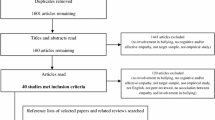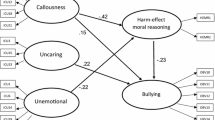Abstract
Although knowing and feeling the emotions of other people might result in less bullying, we argue that not caring about these feelings will also be important. That is, what good is empathy, if one does not care about the feelings or values of others? We examined self-reports of callous-unemotional traits (CU: Inventory of Callous-Unemotional Traits), bullying, and empathy in 201 children (ages 11–12 years). Results show children high on CU to be lowest in affective empathy and highest in direct bullying. While all subscales of the ICU were related to affective empathy, only the uncaring subscale was uniquely related to cognitive empathy. Empathy did not explain differences in bullying when taking into account CU traits. Therefore, failing to care about others is more important than empathy for explaining the direct and indirect bullying these children take part in. Implications for targeting different forms of empathy in treatment are considered.


Similar content being viewed by others
References
Olweus D (1993) Bullying at school: what we know and what we can do. Blackwell Publishing, Oxford
Byrne B (1995) Coping with bullying in schools. Cassell Education, London
Guerin S, Hennessy E (2002) Aggression and bullying. Blackwell Publishing Co, Oxford
Crick NR, Grotpeter JK (1995) Relational aggression, gender, and social-psychological adjustment. Child Dev 66:710–722
Björkqvist K, Österman K, Kaukiainen A (1992) The development of direct and indirect aggressive strategies in males and females. In: Björkqvist K, Niemelä P (eds) Of mice and women: aspects of female aggression. Academic Press, San Diego, pp 51–64
Viding E, Simmonds E, Petrides KV, Frederickson N (2009) The contribution of callous-unemotional traits and conduct problems to bullying in early adolescence. J Child Psychol Psychiatry 50:471–481
Wolke D, Woods S, Bloomfield L, Karstadt L (2000) The association between direct and relational bullying and behaviour problems among primary school children. J Child Psychol Psychiatry 41:989–1002
Jolliffe D, Farrington DP (2006) Examining the relationship between low empathy and bullying. Aggress Behav 32:540–550
Dodge KA, Rabiner DL (2004) Returning to roots: on social information processing and moral development. Child Dev 75:1003–1008
Camodeca M, Goossens FA, Schuengel C, Terwogt MM (2003) Links between social information processing in middle childhood and involvement in bullying. Aggress Behav 29:116–127
Arsenio WF, Lemerise EA (2004) Aggression and moral development: Integrating social information processing and moral domain models. Child Dev 75:987–1002
Bushman BJ, Baumeister RF (1998) Threatened egotism, narcissism, self-esteem, and direct and displaced aggression: does self-love or self-hate lead to violence? J Pers Soc Psychol 75:219–229
Sutton J, Smith PK, Swettenham J (1999) Bullying and ‘theory of mind’: a critique of the ‘social skills deficit’ view of anti-social behaviour. Soc Dev 8:117–127
Barlow A, Qualter P, Stylianou MS (2010) Relationships between machiavellianism, emotional intelligence and theory of mind in children. Pers Individ Dif 48:78–82
Dautanhahn K, Woods S, Kaouri C (2007) Bullying behaviour, empathy and imitation: an attempted synthesis. In: Nehaniv CL, Dautenhahn K (eds) Imitation and social learning in robots, humans and animals: behavioural, social and communicative dimensions. University Press, Cambridge
Kaukiainen A, Björkqvist K, Lagerspetz KMJ, Österman K, Salmivalli C et al (1999) The relationships between social intelligence, empathy, and three types of aggression. Aggress Behav 25:81–89
Björkqvist K, Österman K, Kaukiainen A (2000) Social intelligence- empathy = aggression? Aggress Violent Behav 5:191–200
Dadds MR, Hawes DJ, Frost AD, Vassallo S, Bunn P et al (2009) Learning to ‘talk the talk: the relationship of psychopathic traits to deficits in empathy across childhood. J Child Psychol Psychiatry 50:599–606
Jolliffe D, Farrington DP (2007) The relationship between low empathy and self-reported offending. Leg Criminol Psychol 12:265–286
Anastassiou-Hadjicharalambous X, Warden D (2008) Cognitive and affective perspective-taking in conduct-disordered children high and low on callous-unemotional traits. Child Adolesc Psychiatry Ment Health 2:16–26
Davis MH (1980) A multidimensional approach to individual differences in empathy. JSAS Catalog Selec Docum Psychol 10:85–104
Gini G, Albiero P, Benelli B, Altoè G (2007) Does empathy predict adolescents’ bullying and defending behavior? Aggress Behav 33:467–476
Dadds MR, Hunter K, Hawes DJ, Frost ADJ, Vassallo S et al (2008) A measure of cognitive and affective empathy in children using parent ratings. Child Psychiatry Hum Dev 39:111–122
Frick PJ, White SF (2008) The importance of callous-unemotional traits for developmental models of aggressive and antisocial behavior. J Child Psychol Psychiatry 49:359–375
Edens JF, Campbell JS, Weir JM (2007) Youth psychopathy and criminal recidivism: a meta-analysis of the psychopathy checklist measures. Law Hum Behav 31:53–75
Kimonis ER, Frick PJ, Fazekas H, Loney BR (2006) Psychopathy, aggression, and the processing of emotional stimuli in non-referred children. Behav Sci Law 24:21–37
Loney BR, Frick PJ, Clements CB, Ellis ML, Kerlin K (2003) Callous-unemotional traits, impulsivity, and emotional processing in antisocial adolescents. J Clin Child Adolesc Psychol 32:139–152
Dadds MR, Perry Y, Hawes DJ, Merz S, Riddell A et al (2006) Attention to the eyes and fear-recognition deficits in child psychopathy. Br J Psychiatry 189:280–281
Muñoz LC (2009) Callous-unemotional traits are related to combined deficits in recognizing afraid faces and body poses. J Am Acad Child Adolesc Psychiatry 48:554–562
Blair RJR (1999) Responsiveness to distress cues in the child with psychopathic tendencies. Pers Individ Dif 27:135–145
Fanti KA, Frick PJ, Georgiou S (2009) Linking callous-unemotional traits to instrumental and non-instrumental forms of aggression. J Psychopathol Behav Assess 31:285–298
Dadds MR, El Masry Y, Wimalaweera S, Guastella A (2008) Reduced eye gaze explains “fear blindness” in childhood psychopathic traits. J Am Acad Child Adolesc Psychiatry 47:455–463
Frick PJ (2004) The Inventory of Callous-Unemotional Traits. The University of New Orleans
Kimonis ER, Frick PJ, Skeem JL, Marsee MA, Cruise K et al (2008) Assessing callous-unemotional traits in adolescent offenders: validation of the Inventory of Callous-Unemotional Traits. J Int Assoc Psychiatry Law 31:241–252
Morrissey-Kane E, Prinz RJ (1999) Engagement in child and adolescent treatment: the role of parental cognitions and attributions. Clin Child Fam Psychol Rev 2:183–198
Tattum DP (1993) Understanding and managing bullying. Heinemann Educational Publishers, Oxford
Whitney I, Smith PK (1993) A survey of the nature and extent of bullying in junior/middle and secondary schools. Educ Res 35:3–25
Lagerspetz KMJ, Björkqvist K, Berts M, King E (1982) Group aggression among school children in three schools. Scand J Psychol 23:42–52
Olweus D (1978) Aggression in the schools: bullies and whipping boys. John Wiley, New York
Essau CA, Sasagawa S, Frick PJ (2006) Callous-unemotional traits in a community sample of adolescents. Assessment 13:454–469
Olweus D (1996) The revised Olweus Bully/Victim Questionnaire. Bergen, Norway: Research Center for Health Promotion (HEMIL Center), University of Bergen
Kyriakides L, Kaloyirou C, Lindsay G (2006) An analysis of the Revised Olweus Bully/Victim Questionnaire using the Rasch measurement model. Br J Educ Psychol 76:781–801
Frick PJ, Hare RD (2001) The antisocial process screening device. Multi-Health Systems, Toronto
Muñoz LC, Powell R, Harris K (2008) Callous-unemotional traits are related to poor ability in correctly labeling body poses that communicate fear. Poster presented at the International Conference on Child and Adolescent Psychopathology, Roehampton University, UK
Caldwell MF, Skeem J, Salekin RT, Van Rybroek GJ (2006) Treatment response of adolescent offenders with psychopathy features: a 2-year follow-up. Crim Justice Behav 33:571–596
Pellegrini A, Bartini M (2001) Dominance in early adolescent boys: affiliative and aggressive dimensions and possible functions. Merrill Palmer Q 47:142–163
Author information
Authors and Affiliations
Corresponding author
Rights and permissions
About this article
Cite this article
Muñoz, L.C., Qualter, P. & Padgett, G. Empathy and Bullying: Exploring the Influence of Callous-Unemotional Traits. Child Psychiatry Hum Dev 42, 183–196 (2011). https://doi.org/10.1007/s10578-010-0206-1
Published:
Issue Date:
DOI: https://doi.org/10.1007/s10578-010-0206-1




